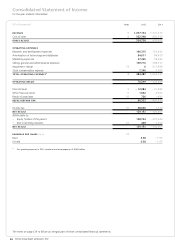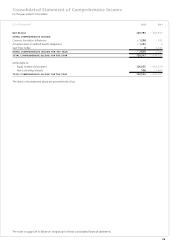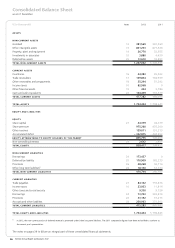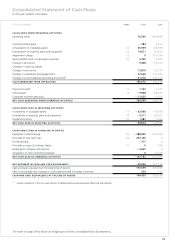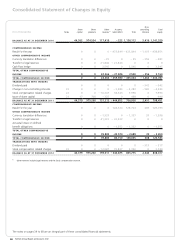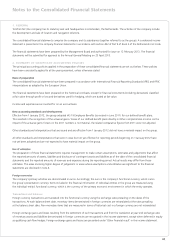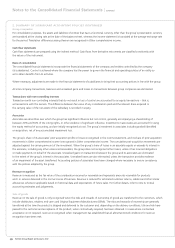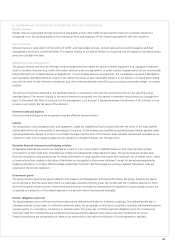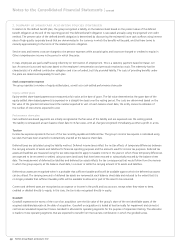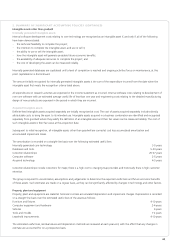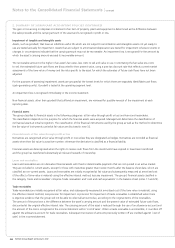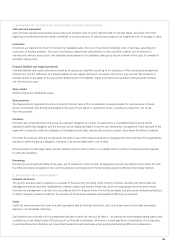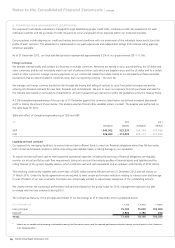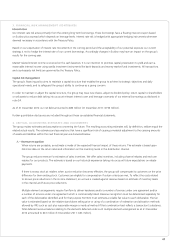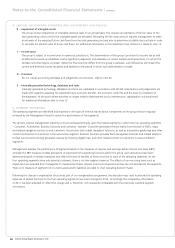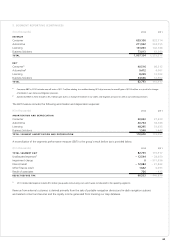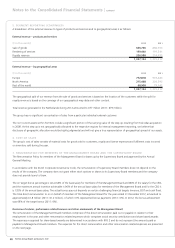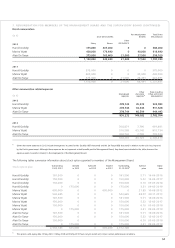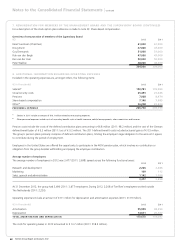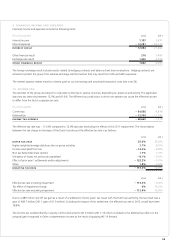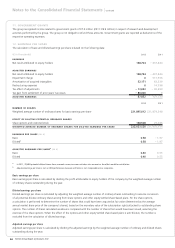TomTom 2012 Annual Report Download - page 46
Download and view the complete annual report
Please find page 46 of the 2012 TomTom annual report below. You can navigate through the pages in the report by either clicking on the pages listed below, or by using the keyword search tool below to find specific information within the annual report.
TomTom Annual Report and Accounts 2012
44
Notes to the Consolidated Financial Statements | continued
2. SUMMARY OF SIGNIFICANT ACCOUNTING POLICIES (CONTINUED)
The gain or loss arising on disposal or retirement of an item of property, plant and equipment is determined as the difference between
the sales proceeds and the carrying amount of the asset and is recognised in profi t or loss.
Impairment of tangible and intangible assets
Assets, such as goodwill, that have an indefi nite useful life which are not subject to amortisation and intangible assets not yet ready to
use are tested annually for impairment. Assets that are subject to amortisation/depreciation are tested for impairment whenever events or
changes in circumstances indicate that the carrying amount may not be recoverable. An impairment loss is recognised for the amount by
which the asset’s carrying amount exceeds its recoverable amount.
The recoverable amount is the higher of an asset’s fair value, less costs to sell and value in use. In estimating the fair value less costs
to sell, the estimated future cash fl ows are discounted to their present value, using a post-tax discount rate that refl ects current market
assessments of the time-value of money and the risks specifi c to the asset for which the estimates of future cash fl ows have not been
adjusted.
For the purposes of assessing impairment, assets are grouped at the lowest levels for which there are separately identifi able cash fl ows
(cash-generating units). Goodwill is tested at the operating segment level.
An impairment loss is recognised immediately in the income statement.
Non-fi nancial assets, other than goodwill that suffered an impairment, are reviewed for possible reversal of the impairment at each
reporting date.
Financial assets
The group classifi es its fi nancial assets in the following categories: at fair value through profi t or loss and loans and receivables.
The classifi cation depends on the purpose for which the fi nancial assets were acquired. Management determines the classifi cation of
its fi nancial assets at initial recognition. The classifi cation of the fi nancial instruments used by the group as well as the method to determine
the fair value of instruments carried at fair value are disclosed in note 32.
Financial assets at fair value through profi t or loss
Derivatives are categorised at fair value through profi t or loss unless they are designated as hedges. Derivatives are recorded as fi nancial
assets when their fair value is a positive number; otherwise the derivative is classifi ed as a fi nancial liability.
Financial assets are derecognised when the rights to receive cash fl ows from the investments have expired or have been transferred
and the group has transferred substantially all risks and rewards of ownership.
Loans and receivables
Loans and receivables are non-derivative fi nancial assets with fi xed or determinable payments that are not quoted in an active market.
They are included in current assets, except for those with maturities greater than twelve months after the balance sheet date, which are
classifi ed as non-current assets. Loans and receivables are initially recognised at fair value and subsequently measured at amortised cost
(if the effect of time value is material) using the effective interest method, less any impairment. The group’s fi nancial assets classifi ed in
the category ‘loans and receivables’ comprise ‘trade receivables’ and ‘cash and cash equivalents’ in the balance sheet (notes 17 and 20).
Trade receivables
Trade receivables are initially recognised at fair value, and subsequently measured at amortised cost (if the time value is material), using
the effective interest method, less provision for impairment. A provision for impairment of trade receivables is established when there
is objective evidence that the group will not be able to collect all amounts due, according to the original terms of the receivables.
The amount of the provision is the difference between the asset’s carrying amount and the present value of estimated future cash fl ows,
discounted at the original effective interest rate. The carrying amount of the asset is reduced through the use of an allowance account and
the amount of the loss is recognised in the income statement within ‘cost of sales’. When a trade receivable is uncollectible, it is written off
against the allowance account for trade receivables. Subsequent recoveries of amounts previously written off are credited against ‘cost of
sales’ in the income statement.


